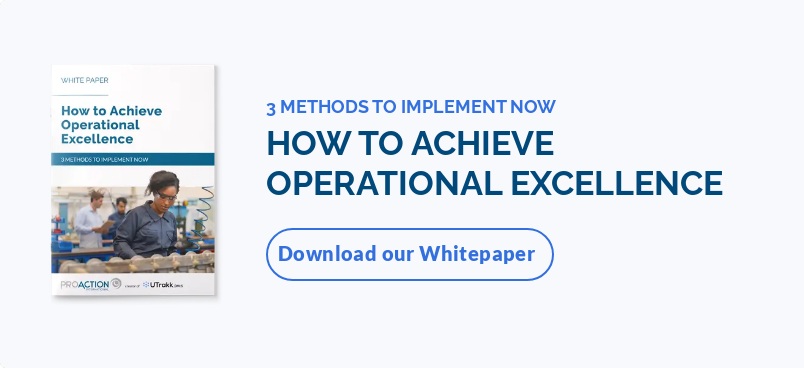What is Lean process improvement?
Lean process improvement focuses on eliminating wasteful activities – such as waste of time, raw materials, or energy – from their operations, and focus on improving every step of the value chain to ensure optimal efficiency and better customer satisfaction.
Process improvement is part of the Lean thinking philosophy, a management approach that supports continuous and sustainable improvements. It is one of the essential techniques used in Lean Management to achieve operational performance objectives.
Toyota first applied the Lean process improvement concept to its production system (the Toyota Production System) in the early 1930s. At the time, the corporation wanted to reduce delays between reception and delivery of an order.
Since then, the Lean concept that was exclusively used in the manufacturing industry is now applied in various industries, including services, technology, and healthcare.

The benefits of improving Lean processes
Organizations adopting the Lean process improvement methodology can reap significant benefits, such as increased efficiency, enhanced competitiveness, and better employee engagement.
Streamlined and efficient operations
Companies that never improve their processes expose themselves to significant waste of time, resources, and energy, which can lead to loss of efficiency, customers, and even employees.
Lean process improvement streamlines operations by identifying process wastes and simplifying workflows. With a better understanding of internal processes, employees become more autonomous and productive, resulting in better management of daily tasks and increased efficiency.
Competitive edge
Adopting Lean principles enables organizations to remain competitive by eliminating unproductive tasks and optimizing processes. This results in increased efficiency that leads to reduced costs and improved quality of products and services.
Lean organizations are in a better position to meet customer requirements and stand out in the marketplace.
Better business agility
Adaptability is crucial in ever-changing markets, and opportunities disappear as quickly as they arise. The principles of Lean approach helps companies remain agile by facilitating the adoption of best business processes and practices, and by adjusting to emerging trends such as sustainability and resource optimization.
This responsiveness to market changes enables organizations to always meet immediate customer needs and drive long-term growth.
Increased employee satisfaction and performance
Lean doesn't only streamline processes; it fosters employee engagement by involving team members in continuous improvement efforts and by enhancing working conditions.
Workers feel valued when they see that their ideas and solutions are considered, which increases well-being and job satisfaction. A happy workforce is more likely to be motivated and productive, contributing to the company's overall success.
7 Steps to improve Lean processes effectively
To effectively improve a Lean process, organizations should follow the steps defined here:

1. Determine areas for improvement
The first step in improving production processes is determining which areas need work. Employees should be involved as they are operating the workflows every day and know wasteful areas that need to be addressed.
2. Identify non-value-added activities
Analyze the value stream to identify the process steps that directly contribute to creating customer value and those that generate non-value-added activities (or waste).
Any unnecessary activity should be reviewed to find solutions to either reduce or eliminate waste.
3. Find potential solutions
Once the identification period has been completed, involve employees in problem resolution – chances are they already thought about potential solutions and perhaps have even discussed them with their peers. It reinforces their sense of belonging and team spirit.
4. Implement improvements
To implement the solutions, all organization members must understand and adhere to the new manufacturing process. Training is highly recommended to help employees get onboard with the changes and see how easier they can make their lives.
Once all stakeholders understand the process, implementation can begin.
Pro tip: Structured project management is often required to coordinate tasks, keep track of deadlines and statuses, and ensure that resources are used effectively.
5. Monitor results and adjust
There's no such thing as overall success on the first attempt to improve a Lean process. Continuous refinement is always necessary after a solution has been tested on the shop floor. This is the continuous improvement cycle, where consistent monitoring and adjustment ensure that changes lead to increased efficiency.
6. Standardize new optimized processes
Once the processes have been optimized, they need to be standardized. The new processes must be documented and standardized to ensure they are consistently applied by each employee. This step is essential to avoid going back to the old, inefficient workflows.
7. Use a Daily Management System (DMS) to ensure continuous improvement
UTrakk is a Daily Management System that enables managers to structure and monitor the continuous improvement process efficiently. With features such as digital Gemba Walks and checklists, actions and opportunities, project tracking, and dashboards, the platform helps quickly identify problems and improvement opportunities, create action plans, and track them – all through a seamless and collaborative process.
By centralizing continuous improvement indicators, UTrakk makes progress easy to measure. This facilitates the management of continuous improvement initiatives and the implementation of effective, impactful changes into daily operations.
The solution also includes a Knowledge Center for documenting standardized processes, procedures, and work instructions. Teams can easily refer to this useful documentation, ensuring compliance to work processes.
Leverage Lean Manufacturing methods and tools
Many Lean methods and tools can help improve any production process. They are very useful when it comes to being organized, identifying opportunities, and implementing action plans.
- 5S: This systematic approach is used in manufacturing to improve the work environment’s efficiency. It includes five key principles – Sort, Set in Order, Shine, Standardize, and Sustain – that eliminate waste and guarantee that all necessary tools (physical or virtual) are available in the right places through visual management.
- Six Sigma: The Six Sigma methodology also improves efficiency and reduces waste. It is mostly used in large-scale, waste-prone industries that aim to perfect operational efficiency, as it enables them to standardize complex workflows. Six Sigma focuses on two methodologies: DMAIC (Define, Measure, Analyze, Improve, and Control) for progressive improvement of current processes, and DMADV (Define, Measure, Analyze, Design, Verify) for optimizing new processes or products.
- PDCA cycle: This tool is used for problem-solving and for continuous improvement of a product’s or service’s quality. It consists of four steps: Plan, Do, Check, and Act. These steps are organized in a cyclical fashion (Deming Wheel), continuously repeated over time.
- 5 Whys: This technique involves asking the question “Why?” five times to identify the root cause of a problem. Each answer leads to another question, enabling teams to dig deeper to discover the root of a problem. This approach is handy for solving complex or recurring problems.
- Gemba Walks: Gemba means “actual place” in Japanese. The Gemba Walk involves going directly on the shop floor where processes are executed, to observe, ask questions, and understand how work is done. This Lean Management practice enables managers to better understand the realities on the floor, identify potential problems and solutions, and build a continuous improvement culture.
Other Lean Manufacturing methods and tools are available, such as Toyota Kata, Ishikawa diagrams, FMECA analysis, affinity diagrams, Kanban, Business Process Management (BPM), and Kaizen. Lean organizations can combine them according to their specific needs to identify areas for improvement and implement solutions more effectively.
Lean process improvement ideas to implement in your company
Lean process improvement can be applied to many work processes, in various industries. Here are some examples of process enhancements:
Manufacturing
It is one of the industries that most integrates the principles of Lean methodology into its operations. A good example is the use of Just-in-Time (JIT) to reduce inventories in production, thus cutting storage costs and reducing waste.
In addition, the implementation of continuous quality controls enables problems to be detected and corrected in real-time, even before products reach the final stage or are shipped to customers.
Logistics
Lean helps streamline logistics operations by identifying and eliminating waste throughout the supply chain. For example, optimizing route choices and precisely synchronizing production with customer demand reduces transport costs and minimizes waiting times and unnecessary storage costs.
These improvements contribute to a smoother, more responsive supply chain.
Aerospace
In this industry where precision and safety are crucial, the Lean approach improves efficiency and reduces errors. For example, using U-shaped production cells optimizes the movement of employees and parts, reducing cycle times and the risk of errors.
Furthermore, using standardized checklists for each manufacturing stage ensures that every component complies with the strictest quality standards, thus avoiding high costs for rectification or delays.
Achieve operational excellence with Lean process improvement
Lean process improvement goes beyond eliminating waste and time-consuming activities; it is a strategic driver to achieve continuous improvement and ensure sustainable growth. By adopting a structured approach and involving all levels of the organization, companies can transform their operations and enjoy optimized productivity, enhanced quality, and increased customer satisfaction.
Successful implementation of Lean principles, combined with powerful tools and technologies like UTrakk DMS, leads to the creation of robust processes enabling you to rapidly adjust to market changes.
Lean process improvement becomes a fundamental driver of innovation and performance, a clear path to operational excellence.










